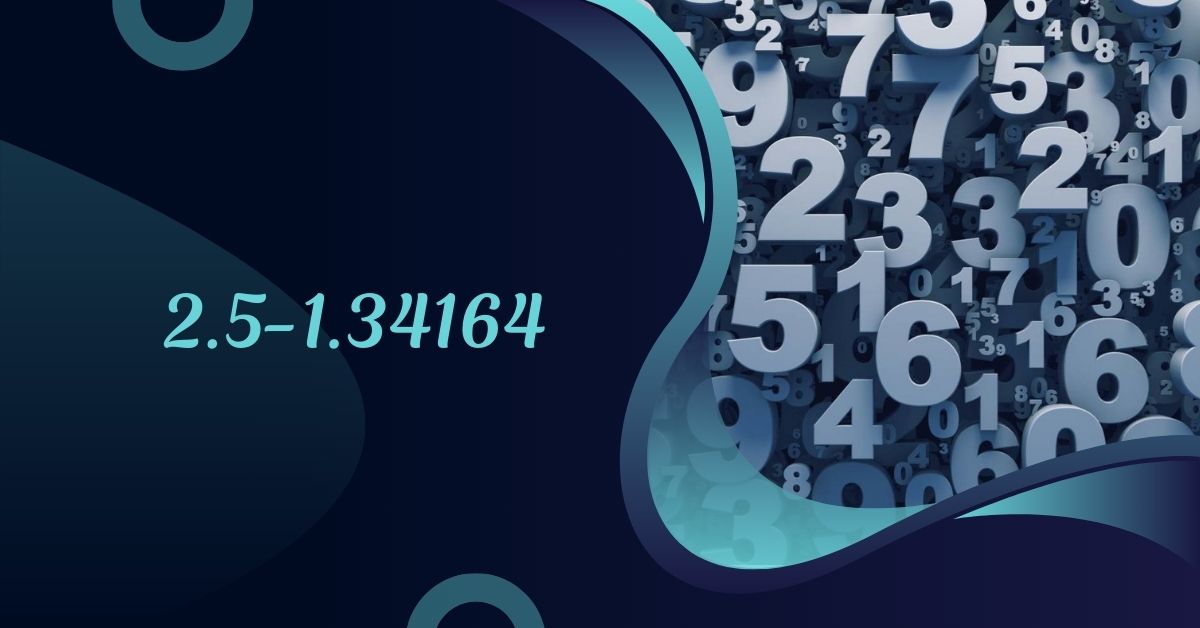When you encounter the mathematical expression “2.5-1.34164,” it might seem like just a simple subtraction problem. However, this expression, once analyzed, can reveal deeper insights into a variety of fields including mathematics, economics, and even personal finance.
In this comprehensive guide, we’ll explore the significance of “2.5-1.34164,” examine its practical applications, and delve into why this specific calculation might be important.
Introduction to “2.5-1.34164”
What Is “2.5-1.34164”?
The expression “2.5-1.34164” represents a simple subtraction problem where you subtract 1.34164 from 2.5. This calculation results in 1.15836. While it may appear straightforward, understanding its implications can reveal important insights.
Why Is This Calculation Important?
On the surface, this calculation might seem trivial, but it serves as a base for various practical applications. Whether in financial planning, engineering design, or everyday life, understanding how to perform and interpret this calculation can be quite valuable.
Mathematical Breakdown
Basic Calculation
Let’s start with the basic arithmetic:
2.5−1.34164=1.158362.5 – 1.34164 = 1.158362.5−1.34164=1.15836
This result is derived from subtracting a smaller decimal (1.34164) from a larger decimal (2.5).
The Significance of Precision
In many applications, precision matters. For example, in financial contexts, precise calculations can make a big difference in budgeting and forecasting. The decimal places in “2.5-1.34164” are crucial for ensuring accuracy in these contexts.
Understanding Decimal Places
Decimals are used to represent fractions of a whole number. In “2.5-1.34164,” we are dealing with decimals that extend to five places. This level of precision ensures that the result is accurate and can be used in detailed financial reports or engineering calculations.
Practical Applications
Economics and Finance
In finance, precise calculations are vital. For example, if you’re calculating interest rates, loan payments, or investment returns, you need to ensure accuracy to make informed decisions. The calculation “2.5-1.34164” could be part of a larger financial formula or analysis.
Engineering and Technology
Engineers often deal with precise measurements and calculations. Whether designing a bridge, a machine, or a piece of software, every decimal point can impact the overall outcome. In engineering projects, the result of “2.5-1.34164” might be used to determine tolerances or specifications.
Everyday Scenarios
In daily life, this calculation can be used for budgeting or other financial planning. For instance, if you have a budget of $2.50 and spend $1.34, you would use the calculation “2.5-1.34164” to find out how much money remains.
The Impact on Decision Making
Financial Forecasting
Accurate calculations are essential in financial forecasting. By using precise numbers, you can better predict future financial scenarios, assess risks, and make informed decisions. The calculation “2.5-1.34164” could be a small part of a larger financial model.
Engineering Projects
For engineers, precision is critical. A small error in calculations can lead to significant issues in construction or design. Understanding how to accurately perform and interpret calculations like “2.5-1.34164” ensures that engineering projects are successful and safe.
Personal Budgeting
Personal budgeting requires careful calculation. By understanding how to subtract amounts accurately, you can better manage your finances and make sure you stay within your budget.
Case Studies and Examples
Example 1: Financial Budgeting
Imagine you have $2.50 left in your monthly budget and need to purchase an item costing $1.34. To determine if you can afford it, you would subtract $1.34 from $2.50. The result, $1.15836, shows that you have enough money to make the purchase, with a small balance remaining.
Example 2: Engineering Design
In engineering, precise measurements are essential. Suppose you’re designing a component that must fit within a specific tolerance range. If your measurement is 2.5 units and the tolerance is 1.34164 units, subtracting these values helps you determine the allowable deviation from the standard measurement.
Example 3: Everyday Use
Let’s say you have a total of $2.50 in loose change, and you spend $1.34 on a snack. By performing the calculation “2.5-1.34164,” you find that you have $1.15836 left, which helps you understand how much money you have remaining.
Advanced Analysis
Statistical Relevance
In statistical analysis, precision and accuracy are crucial. The difference represented by “2.5-1.34164” might be part of a larger dataset where every decimal point counts. Understanding how small differences impact results can lead to more accurate statistical conclusions.
Error Margins and Accuracy
When dealing with precise calculations, error margins are important. Small errors can accumulate and affect the overall results. The calculation “2.5-1.34164” demonstrates the importance of accuracy in ensuring reliable outcomes.
Comparative Analysis
Comparing different calculations or data points often requires precise subtraction. By analyzing the difference between values like 2.5 and 1.34164, you can gain insights into trends, patterns, and anomalies in various fields.
Frequently Asked Questions (FAQs)
What Does “2.5-1.34164” Mean in Financial Terms?
In financial terms, “2.5-1.34164” might represent the calculation of remaining funds after a transaction. This could be part of budgeting, financial analysis, or investment calculations.
How Does Precision Affect Calculations?
Precision affects calculations by ensuring that results are accurate and reliable. In fields like finance and engineering, even small errors can lead to significant issues, making precise calculations essential.
Can “2.5-1.34164” Be Applied in Real-World Scenarios?
Yes, “2.5-1.34164” can be applied in various real-world scenarios including financial planning, engineering design, and personal budgeting. Understanding how to perform and interpret this calculation can help in making informed decisions.
Conclusion
The expression “2.5-1.34164” might seem like a simple mathematical problem, but its implications stretch far beyond basic arithmetic. From financial forecasting and engineering design to personal budgeting, understanding and accurately performing this calculation can have a significant impact. By exploring its practical applications and advanced analysis, we can appreciate the value of precision and accuracy in various fields.










